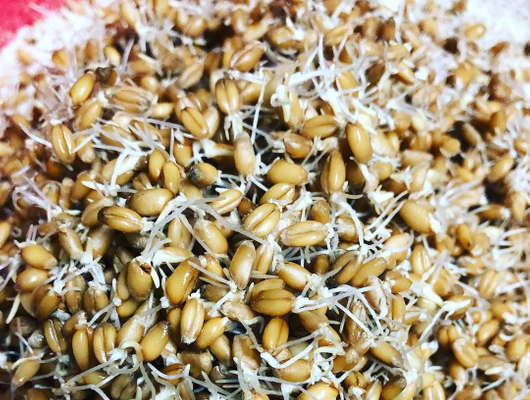SPROUTING GRAINS
Sprouting grains increases the nutritive value of the individual grains by cracking open the hull of the grain; as well, the transformative process the grain goes through in sprouting effectively pre-digests the grain for you, allowing your body better access to the nutrients in it. It’s also a delicious addition to any loaf of bread — more on that later.
Most grains and dry beans can be sprouted. Here’s an incomplete list of the grains we commonly enjoy sprouting:
- Quinoa
- Rye
- Wheat
- Buckwheat
- Millet
- Bulgur
- Amaranth
- Kamut
- Spelt
- Farro
- Maize
- Rice
- Any dried bean
Grains are really seeds, and like the plants they represent, grow into something beautiful. Because the sprouting process cracks open the hard bran on the outside of the grain’s shell, most sprouted grains can be eaten raw; they are transformed from hard, fibrous packages into flavorful chewy energy envelopes. Whereas before the sprouting, many of the nutrients on the inside of the grain — the endosperm — would have simply passed through the body, in a sprouted grain those vitamins and nutrients are absorbed during digestion! 🎉
A shoutout to Joe Munoz, who requested this recipe. Your feedback is important to us! Don’t be afraid to Contact Us with your own recipe requests!
Using sprouted grains in sourdough
For reference, check our Simple Sourdough recipe for when to incorporate the grains into the dough. This can really up the protein level of your bread!
Ingredients
- 250 g (or around 2 cups) of grain
- 500 g (around 4 cups) of water
- mason jar or other sprouting container
- cheesecloth or porous towel
Steps
- Soak the grains in the water overnight
- Drain the water and cover your mason jar or whatever you’re using to sprout the grains with the cheesecloth or a towel thin enough to let the grains breath.
- Wait. At the beginning and end of each day after you first drained the water, wet the grains by running water over them and then again draining.
- The grains should start sprouting within the first 24 hours, but a good rule of thumb as to when they’re done is for the sprout to be roughly the same length as the grain.
- Enjoy! Sprouted grains can be incorporated into salads, raw, or are excellent additions into sourdough bread. Check out our simple sourdough recipe to get started on that!
Rate our recipe!
Thanks for reading our recipe and we really hope you enjoyed it! We're always happy to get feedback on the quality our recipes provided - if you liked it, make sure you click on the fifth ⭐ to give this recipe a top-notch rating.

